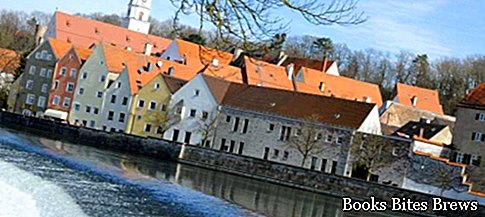What to see in the town of Bavaria located in the south of Germany, a medieval village among the main stages located along the famous Via Romantica, description of a suggestive itinerary to discover the historic center starting from the main square to get to the lard tower, between monuments, fortifications and unmissable panoramas.
Tourist information
In the center of the city, on Hauptplatz, the old town hall was previously located, replaced by today's construction of the 1700s which, although integrated into the row of western houses, is markedly distinguishable by the facade richly decorated with stucco.
It is a work by the same architect of the famous Wieskirche church, Dominikus Zimmermann, who also decorated the rooms on the upper floor in stucco.
Under his direction, the Church of St. John of Landsberg was erected in 1752, where he was mayor in 1749, almost simultaneously with the period of construction of the Wieskirche, between 1746 and 1754, his greatest masterpiece.
In front of the Town Hall there is a beautiful fountain with the statue of the Madonna.
Hubert Von Herkomer Strasse takes us to the Lech River, where it is worth taking a short detour on the bridge and along the promenade to the right to be able to admire a wonderful view of the city.
An interesting tower house on the western bank, the Mutterturm, was built at the end of the nineteenth century as the home and studio of the painter and graphic designer Von Herkomer, whose tutor's collection is exhibited in this place.
Returning to the bridge and keeping to the left to follow the Hintere Salzgasse at the height of Inselbad, you can see regular terraced houses, which highlight how narrow the space is between the river and the steep slope.
What see
At the end of the row of houses and keeping on the left side, along the Robmarkt, you reach two former fortified gates, the Farbertor external door, and the 15th century Bayertor tower door, both from the 15th century.
Following the Vordere Anger to the left, you arrive at the Church of San Giovanni, well integrated into the harmonious framework of the streets which closes with the Sandauer door from 1630.
This fortified northern gate adjoins the Staffingerhof palace, formerly the residence of the Landsberg League founded in 1556, an organization which remained active until 1599 and aimed to defend against Protestantism.
Recommended readings- Dresden (Germany): what to see
- Octoberfest (Germany): beer festival in Munich
- Stuttgart (Germany): what to see
- Hamburg (Germany): what to see in the main port
- Hohenfurch (Germany): what to see
Subsequently the building, embellished with an arched courtyard and also used for tournaments, passed into the hands of the Dukes of Bavaria.
Along the Hintere Anger you reach the majestic church of Santa Maria Assunta, where you can admire the remarkable stained glass windows of the 16th century, the stuccos and carving works by Lorenz Luidi, the donkey of Palm Sunday and the Madonna Multscher are instead of Hans Multscher.
A staircase leads to the area where the Jesuit convent was once located.
Near the door of the Church of Santa Croce, there is the entrance to the beautiful arched courtyard that was part of the Jesuit college.
The church, simple on the outside, shows the best of itself on the inside, with stuccos, frescoes, paintings and carved confessionals.
In the former Jesuit gymnasium, the municipality has set up a museum where numerous testimonies of city life are exhibited, as well as works of art from numerous churches, among which one of the most precious is the sculpture that represents the Coronation of Mary.
The route continues climbing up to the imposing Bayertor tower gate, whose tower, 36 meters high, allows a unique view of the old city, with the suggestive alpine chains in the background, in case of good visibility conditions.
As soon as you exit the door you will find the tourist signs that invite you to follow the walk outside the walls to the Jungfernsprungturm tower.
Nearby, where the moat is located, going back a few meters, you return to the historic center, characterized by houses whose numbering does not take into account the streets.
From Mount ScholoBberg, after looking at the panorama, you face a steep descent passing through the picturesque "witches' quarter" before reaching the "lard tower", named in this way by the custom that the farmers had to sell their products, and the adjacent Hauptplatz.




